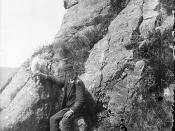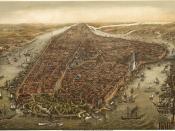When the average person reads "Paul's Case" by Willa Cather, they interpret a story about a depressed teenager who steals money, runs away to New York City, and commits suicide. On the surface there is little reasoning behind Paul's decisions. The reader cannot fully understand Paul's motivation until the story is considered on a deeper level. Upon further observation, Cather creates numerous references to flowers within Paul's mundane life. This was not done carelessly--the flowers represent Paul. Paul's struggles, ambitions, and death can all be traced back to the symbolism of flowers.
In the opening scene of the story, Paul is being kicked out of school. He appears before his teachers to debate his suspension. "His clothes were a trifle outgrown, and the tan velvet on the collar of his open overcoat was frayed and worn..." (1), but in contrast, he wore a red carnation in his buttonhole.
Flowers are a symbol of status, but Paul is a mere boy on the verge of suspension. His teachers see this flower and are thrown off-guard. The red carnation was worn in defiance of his teachers. Just as the flower can exist in any setting, Paul can exist with or without the approval of his teachers. He doesn't need his teachers' approval to be successful. In this instance, his flower got his point across.
Everywhere Paul goes, he notices flowers, from the "red-glass pitcher, ornamented with blue forget-me-nots in blue enamel" (23), to the "violet water from the bottle he kept hidden in his drawer" (27), to his desire for "soft lights and fresh flowers" (19). When writing this story, Cather could have described any design on the lemonade pitcher, but intentionally decorated it with forget-me-nots. Flowers are a part of Paul's life just as a favorite color or...


